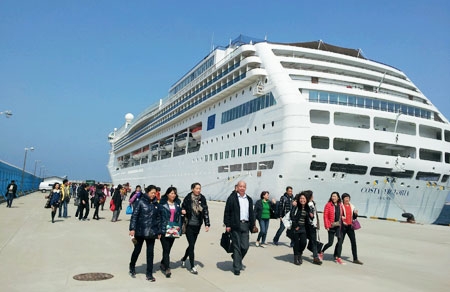Asia Cruise Industry continues to grow

Bangkok : Asia has been confirmed as the world’s fastest growing source of cruise passengers, with a new Cruise Lines International Association (CLIA) report showing the region experienced an unprecedented 24% increase in passenger numbers last year.
According to CLIA’s Asia Cruise Trends study, the cruise industry in Asia is growing at a record pace, with 2.08 million people from the region taking an ocean cruise in 2015.
The report shows that China accounted for almost half the region’s cruise passengers, with 986,000 passengers from mainland China taking a cruise in 2015, up 40% from 703,000 in 2014. This figure makes China the world’s fastest growing source nation for cruise passengers in 2015, with other leading source markets like Hong Kong (126,800), India (125,900), Japan (179,900), Singapore (182,700) and Taiwan (228,700).
The report also confirms the continued growth in sailings in the region with 1560 sailings scheduled for 2016, up 43% on last year.
“The cruise industry has been nimble and responded quickly to the demand for cruise travel in Asia by delivering cruise ships with amenities and experiences tailored to Asian travellers,” said CLIA President and CEO, Cindy D’Aoust. “Asian cruise travel has also become an enticing way for international guests to visit Asia’s fascinating destinations in a comfortable and convenient way.”
CLIA Asia Secretary General, David Goh, said, “Cruise tourism in Asia has also been gaining increasing traction with double-digit growth rates as more consumers in the region are exploring it as an alternative choice of vacation. China, Japan, Malaysia, South Korea and Vietnam are the top five destinations in Asia, experiencing more than 4,000 calls in total.”
Other key findings from the Asia Cruise Trends report include:
Cruise Ships – This year, 60 ocean cruise ships will sail in Asia versus 43 ships in 2013, 15% more ships than the 52 operating in 2015. Of the ships sailing this year, 14 operate year-round while another 12 have extended deployments in Asia.
More Cruises – There has been a significant increase in the number of days cruise ships are in operation, from 4307 operating days in 2013 to 7918 in 2016.
Capacity Boost – The capacity to carry passengers continues to grow, surging by 54% in 2016. As a result, the overall passenger capacity on ocean cruise ships will reach 3.2 million in 2016.
Chinese Passengers – From 2012 to 2015, the number of Chinese passengers grew at an annual compounded rate of 66%.
Shorter Cruises – Passengers from the region continue to prefer shorter ocean cruise lengths. In 2015, almost 30% of passengers continued to choose cruises two to three nights in length and half chose four to six night cruises (83% of those originating in China). Almost a fifth of passengers chose extended cruises of seven to 13 nights. As a result, the average length of cruises offered in the region has increased slightly from 5.2 nights in 2014 to 5.3 nights in 2015.
Destinations – Cruising in the region includes more than 204 destinations across 17 countries, making travelling by cruise ship one of the easiest ways to see multiple destinations throughout Asia. While the introduction of new ports throughout Asia is great for travellers, it is also great for local economies, bringing more visitors to Asian destinations.
Japan is again the biggest destination country with 1526 port calls in 2016, followed by China (850), South Korea (745), Vietnam (466) Malaysia (422) and Singapore (391).
The most visited port in 2016 will be Jeju Island, South Korea (460 calls), closely followed by Shanghai (437), Singapore (391) and Fukuoka (258).
Source: Asia Travel Tips , Aug. 2016















